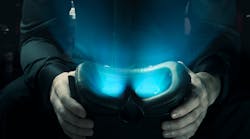It's a perennial dilemma for the electrical transmission and distribution (T&D) industry. How do you safely train personnel who will be working on and around dangerous, high-voltage substation equipment without exposing them to actual danger during training?
Until now, the answer was to spend hours in a classroom setting, with participants relying on volumes of printed materials and hours of video instruction and live lectures from trainers.
But now, virtual reality (VR) technology is the emerging tool to greatly improve this training model.
VR gaming and other similar uses of this technology are well known to the general public, but the potential benefits of using VR technology for advanced training in many sectors is only being explored now. In the T&D industry, the first and most obvious benefit is to take a giant leap forward in effective safety training without exposure to actual safety hazards.
No replacement for real-world experience
Even the most advanced technology tools cannot adequately be used as a substitute for the actual experience of learning safe processes and procedures under field conditions. The ability of humans to learn and retain knowledge depends largely on repetition and practice.
This learning gap is the essential dilemma faced by all training, whether it is delivered in the classroom via conventional means such lectures, videos, or textbooks, or through new VR tools. The ability to retain the information and knowledge presented in a classroom or virtual environment must be reinforced as soon as possible by application in real-world conditions. That's why it is critical for safety information — presented prior to implementation in the field — to be retained.
Benefits of VR training
The first job of safety training is to keep participants safe while undergoing training. This is the reason behind the Occupational Safety and Health Administration (OSHA) 40-hour training. The repetition of information and material is essential, so that participants can retain instruction and translate it into safe practices when performing actual operations in a substation or any other location where they may be exposed to high-voltage equipment.
An advantage of VR training modules is they can address some of the shortcomings of conventional classroom learning, serving to bridge the gap of traditional classroom learning by translating better into real-world experiences.
VR training modules allow participants to experience ultra-realistic simulations of procedures performed in a substation environment, enabling them to experience the effects of hazards they will likely face on the job site. Mistakes are apparent immediately, but the risk of injury or fatalities is zero. The whole point is to train safely by following detailed work procedures, obtaining critical knowledge through repetition before the participants expose themselves or their co-workers to an actual hazard.
Three broad applications
The potential for VR as a training tool is immense and the technology can be designed to fit training objectives ranging from simple to complex. While there are infinite combinations, we generally classify VR training modules into three categories:
1. The sandbox: Under this approach, participants work from a desktop application to walk through a simulated substation environment, confronting questions at different points in the journey. These are usually set up with multiple-choice answers; a correct answer is required to move on to the next phase of the journey.
2. Final-stage qualification confirmation: In this second and more detailed application, a participant would be required to walk through the substation, answering more complex questions. This final-stage confirmation demonstrates personnel are qualified to follow all safety procedures in real-world conditions.
3. Custom virtual training: This category is the most complex of the three because it requires creating a virtual model of an actual substation, while creating multiple training scenarios based on actual safety procedures designated for that substation. The scenarios are modeled to give participants sensory perceptions of what it is like to be working around energized, hazardous components.
Utility training pilot
Kansas City, Missouri-based Evergy is exploring a customized VR training module developed from three-dimensional (3D) scans and drawings of a critical high-voltage substation. By working with a site manager and safety director at the utility, Burns & McDonnell is creating a number of training scenarios, providing on-site personnel the ability to conduct virtual walkthroughs of entire substations.
This realistic training program is similar to what participants might see in an advanced video game, with participants having multiple options of pathways they can walk through or actions they can perform. By choosing a specific training module, participants are confronted with a number of tasks, all with scenarios based on the actual equipment within the substation.
Participants can launch the program by walking through the gate, while independently deciding their pathway through the facility. With VR and the power of custom programming, participants may walk up to a fence and then be required to go through a step-by-step checklist of safety procedures — with requirements to complete and virtually check off each step — before proceeding to the next phase. For example, they may walk up to the fence and be asked, "Is this fence grounded?" After confirming, they can proceed to the next phase of the walkthrough.
The sequence will be designed to conform with the existing safety program to simulate the training required, while on-site. Participants who make mistakes receive a notification of their errors and have the chance to make corrections and adjustments without being exposed to hazardous conditions of a real-world substation.
How we create the program
3D design models serve as the basis of VR simulations. We start by uploading 3D design data into VR design software. As needed, we can customize digital images based on engineering drawings and other sources. Many components are also available from a number of digital libraries, providing access to extensive inventories of electrical components and parts based on manufacturing specifications. This enables the VR training module developer to avoid the labor-intensive process of developing custom digital images.
These inventories allow us to create modules of components, designed to move and rotate in motions as typically seen. We can achieve high-resolution detail for accurate representations, including fasteners or connectors that might be used. For example, we might want to create training modules on test switches or equipment cabinets that would test the proficiency of participants. Focusing on these precise components for that training, specific modules can be created, while leaving the surrounding elements and equipment in a less detailed and abstract presentation. VR provides the flexibility to create detail in targeted zones, depending on the exact training required.
Sustainability and cost benefits
An additional and very important benefit touches on the area of sustainability and cost. With a VR program, physical resources are not exhausted because there is no need to expend fuel, time, and other resources by sending teams to the job site for days of intensive training. Because of the scalable nature of applications and software, any number of modules can be deployed to employees, a handful or hundreds all at once. The only limitation is the number of computers, monitors, or devices available. The savings in time can become extensive, as larger numbers of staff get trained together, instead of in stages over a series of weeks or months.
The way forward
VR training has the potential to improve how we learn, while increasing the safety of employees. Even for subject material, where strong interests exist, some struggle to retain information presented.
By placing learners in environments that involve a complete sensory experience — including sounds, vibrations, and visual perceptions — we begin to feel like we are present in a given environment. We know how easy it is to learn when you are having fun and emotionally engaged.
Though video gaming might be the most well-known application of VR technology, it may only be the starting point, as many businesses and industries begin tapping VR's vast potential.


